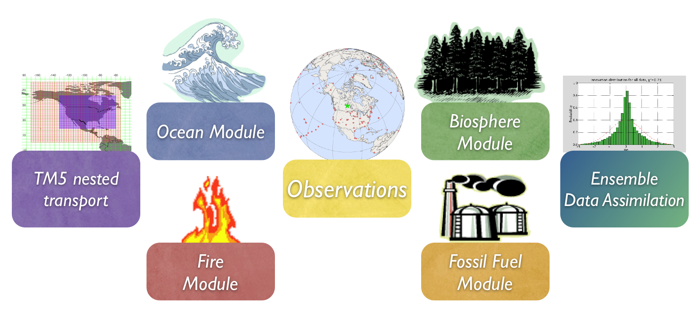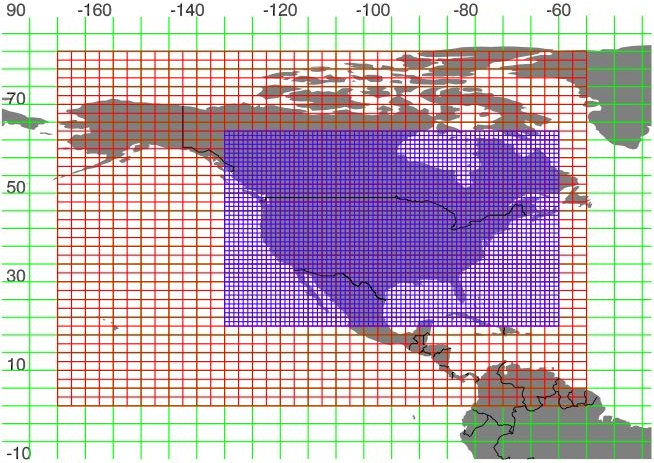|
Information
Results
Get Involved
Resources
|
|
|

|
To learn more about a CarbonTracker component, click on one of the above images.
Or download the full PDF version for convenience.
|
1. Introduction
The link between observations of CO2 in the atmosphere and the exchange of CO2 at the Earth's surface is formed by transport in the atmosphere: storm systems, cloud complexes, and weather of all sorts that transports CO2 around the world and causes local events (fires, forest growth, ocean upwelling) to have impacts on much larger scales. (However, unlike in some climate models, the meteorology we use is fixed and we do not allow the carbon fluxes we estimate to feed back into our transport simulation.) To simulate the winds and the weather, CarbonTracker uses sophisticated numerical models that are driven by the daily weather forecasts from the specialized meteorological centers of the world to transport CO2 across large distances. Since CO2 does not decay or react in the lower atmosphere, the influence of emissions and uptake in for instance North America and Europe are ultimately seen in our measurements even on the South Pole! Getting the transport of CO2 just right is an enormous challenge, and costs us almost 90% of the computer resources for CarbonTracker. The development of the atmospheric transport model, in our case the Transport Model 5 (TM5), is shared among many scientific groups with different expertise. In addition to CarbonTracker, TM5 is also used to make air-quality forecast, study the dispersion of aerosols in the tropics, track biomass burning plumes, and to predict what pollution levels future generations might have to deal with.
2. Detailed Description
TM5 is a global model with the option for two-way nested grids; arbitrary regions with high-resolution grids can be nested in a much coarser grid spanning the global domain. Thus, transport simulations can be performed with a regional focus, without the need for boundary conditions from other models. This approach allows measurements outside the domain of interest to constrain regional fluxes in the data assimilation, and ensures that regional estimates are consistent with global constraints. TM5 is based on its predecessor TM3, with improvements in the advection scheme, vertical diffusion parameterization, and meteorological preprocessing of the wind fields (Krol et al., 2005). The model is developed and maintained jointly by the Institute for Marine and Atmospheric Research Utrecht (IMAU, The Netherlands), the Joint Research Centre (JRC, Italy), the Royal Netherlands Meteorological Institute (KNMI, The Netherlands), and NOAA ESRL (USA). In CarbonTracker, TM5 simulates the separate processes of advection, convection (deep and shallow), and vertical diffusion in the planetary boundary layer and free troposphere.

TM5 is driven by meteorological data from the European Center for Medium range Weather Forecast (ECMWF) model that currently runs with ~25 km horizontal resolution and 91 layers in the vertical (T799L91) and can also use meteorological data from the National Center for Environmental Prediction (NCEP) forecast. The preprocessing of this data for use in TM5 is done routinely for the global domain (3x2 degrees), as well as for several nested 1x1 degree domains (North America, Europe, Asia). In CarbonTracker, TM5 is run at a global 6x4 degrees resolution with nested regions over North America (3x2 degrees) and the United States (1x1 degree) similar to the set-up in Peters et al., [2004, 2005]. The grid over North America is shown in the figure. TM5 runs at an external time step of three hours, but due to the symmetrical operator splitting and the refined resolution in nested grids, processes at the finest scale are repeated every 10 minutes. The vertical resolution of TM5 in CarbonTracker is 25 hybrid sigma-pressure levels, unevenly spaced with a larger density near the surface. Approximate heights of the mid-levels (in meters, with a surface pressure of 1012 hPa) are:
| Level | Height (m) | Level | Height (m)
| | 1 | 34.5 | 14 | 9076.6
| | 2 | 111.9 | 15 | 10533.3
| | 3 | 256.9 | 16 | 12108.3
| | 4 | 490.4 | 17 | 13874.2
| | 5 | 826.4 | 18 | 15860.1
| | 6 | 1274.1 | 19 | 18093.2
| | 7 | 1839.0 | 20 | 20590.0
| | 8 | 2524.0 | 21 | 24247.3
| | 9 | 3329.9 | 22 | 29859.6
| | 10 | 4255.6 | 23 | 35695.0
| | 11 | 5298.5 | 24 | 42551.5
| | 12 | 6453.8 | 25 | 80000.0
| | 13 | 7715.4 | |
|
3. Further Reading
|
|
|
|